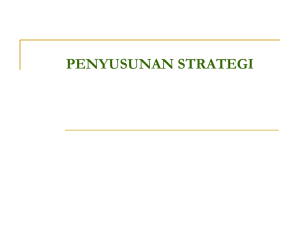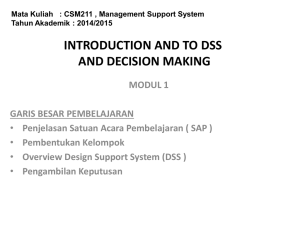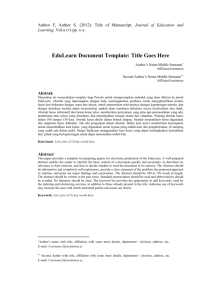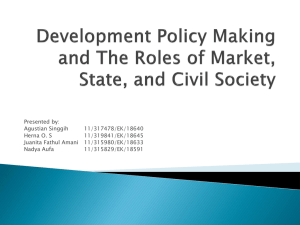ÿþM icrosoft W ord - HANA _ 0 4 1 2 1 4 0 8 6
advertisement
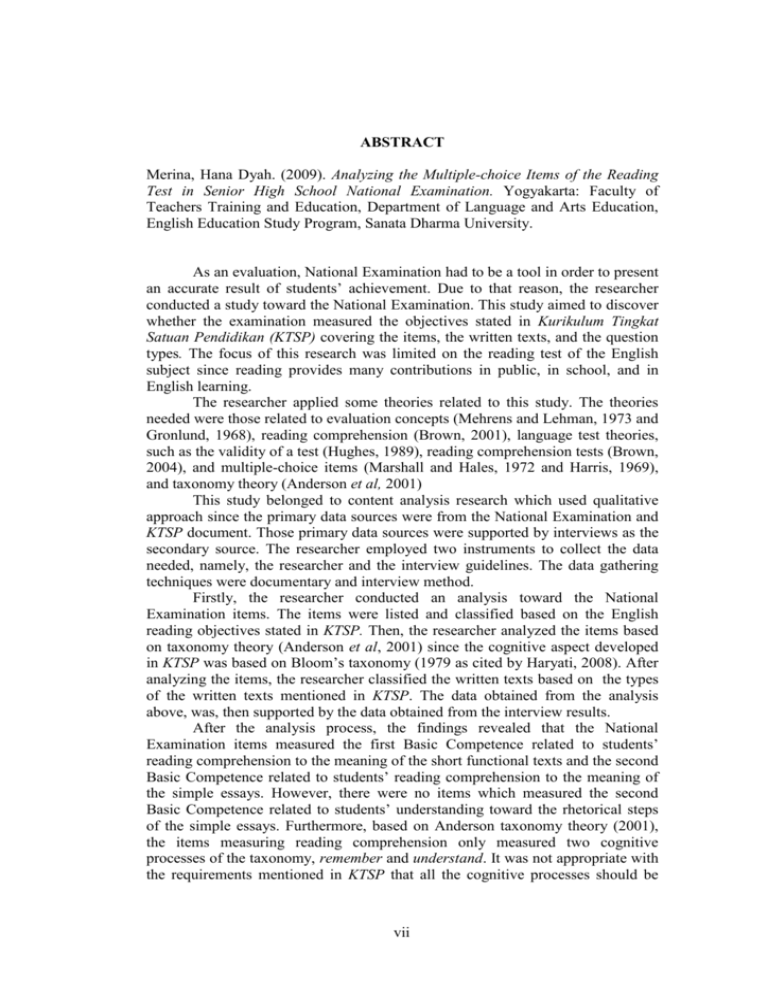
ABSTRACT Merina, Hana Dyah. (2009). Analyzing the Multiple-choice Items of the Reading Test in Senior High School National Examination. Yogyakarta: Faculty of Teachers Training and Education, Department of Language and Arts Education, English Education Study Program, Sanata Dharma University. As an evaluation, National Examination had to be a tool in order to present an accurate result of students’ achievement. Due to that reason, the researcher conducted a study toward the National Examination. This study aimed to discover whether the examination measured the objectives stated in Kurikulum Tingkat Satuan Pendidikan (KTSP) covering the items, the written texts, and the question types. The focus of this research was limited on the reading test of the English subject since reading provides many contributions in public, in school, and in English learning. The researcher applied some theories related to this study. The theories needed were those related to evaluation concepts (Mehrens and Lehman, 1973 and Gronlund, 1968), reading comprehension (Brown, 2001), language test theories, such as the validity of a test (Hughes, 1989), reading comprehension tests (Brown, 2004), and multiple-choice items (Marshall and Hales, 1972 and Harris, 1969), and taxonomy theory (Anderson et al, 2001) This study belonged to content analysis research which used qualitative approach since the primary data sources were from the National Examination and KTSP document. Those primary data sources were supported by interviews as the secondary source. The researcher employed two instruments to collect the data needed, namely, the researcher and the interview guidelines. The data gathering techniques were documentary and interview method. Firstly, the researcher conducted an analysis toward the National Examination items. The items were listed and classified based on the English reading objectives stated in KTSP. Then, the researcher analyzed the items based on taxonomy theory (Anderson et al, 2001) since the cognitive aspect developed in KTSP was based on Bloom’s taxonomy (1979 as cited by Haryati, 2008). After analyzing the items, the researcher classified the written texts based on the types of the written texts mentioned in KTSP. The data obtained from the analysis above, was, then supported by the data obtained from the interview results. After the analysis process, the findings revealed that the National Examination items measured the first Basic Competence related to students’ reading comprehension to the meaning of the short functional texts and the second Basic Competence related to students’ reading comprehension to the meaning of the simple essays. However, there were no items which measured the second Basic Competence related to students’ understanding toward the rhetorical steps of the simple essays. Furthermore, based on Anderson taxonomy theory (2001), the items measuring reading comprehension only measured two cognitive processes of the taxonomy, remember and understand. It was not appropriate with the requirements mentioned in KTSP that all the cognitive processes should be vii achieved. The findings also mentioned that the National Examination had employed the two types of the written texts mentioned in KTSP, short functional texts and simple essays. The question types employed in the National Examination could be categorized into four types: main idea, details, implied details, and vocabulary questions. The vocabulary mastery was measured explicitly and implicitly although the vocabulary mastery was not a requirement in KTSP. viii ABSTRAK Merina, Hana Dyah. (2009). Analyzing the Multiple-choice Items of the Reading Test in Senior High School National Examination. Yogyakarta: Fakultas Keguruan dan Ilmu Pendidikan, Jurusan Bahasa dan Pendidikan Seni, Program Studi Pendidikan Bahasa Inggris, Universitas Sanata Dharma. Sebagai sebuah bentuk evaluasi, Ujian Nasional harus bisa menjadi sebuah alat yang dapat menyajikan hasil akurat tentang hasil belajar siswa. Berdasarkan alasan tersebut, peneliti melakukan sebuah studi pada Ujian Nasional. Studi ini bertujuan untuk mencari tahu apakah Ujian Nasional mengukur tujuan pembelajaran seperti yang tertulis dalam Kurikulum Tingkat Satuan Pendidikan (KTSP) yang meliputi soal-soalnya, jenis-jenis teksnya, dan tipe-tipe pertanyaannya. Fokus utama dari studi ini adalah tes membaca dalam mata pelajaran Bahasa Inggris. Tes membaca dipilih karena membaca memberikan banyak sumbangan secara umum, baik di sekolah maupun dalam mata pelajaran Bahasa Inggris itu sendiri. Dalam studi ini, peneliti memakai beberapa teori. Teori tersebut antara lain teori yang berhubungan dengan konsep evaluasi (Mehrens and Lehman, 1973 dan Gronlund, 1968), teori tentang tes bahasa, seperti kevalidan sebuah test (Hughes, 1989), tes pemahaman bacaan (Brown, 2004), dan soal-soal pilihan ganda (Marshall and Hales, 1972 dan Harris, 1969), serta teori taxonomi (Anderson et al, 2001). Studi ini merupakan analisa dokumen dengan pendekatan kualitatif karena sumber data primernya adalah soal-soal Ujian Nasional dan dokumen KTSP. Data utama tersebut didukung oleh wawancara sebagai sumber sekunder. Peneliti memakai dua instrument untuk mengumpulkan data yang diperlukan, yaitu peneliti sendiri dan panduan wawancara. Teknik pengumpulan data yang digunakan adalah metode dokumentasi dan wawancara. Pertama-tama, peneliti melakukan analisa pada soal-soal Ujian Nasional. Soal-soal tersebut dibuat daftar dan diklasifikasikan berdasarkan tujuan pembelajaran seperti yang tertulis dalam KTSP. Kemudian, peneliti menganalisa soal-soal tersebut berdasarkan taxonomi teori (Anderson et al, 2001) karena penyusunan KTSP didasarkan pada taxonomy Bloom (1979 seperti dikutip oleh Haryati, 2008). Setelah menganalisa soal-soal ujian, peneliti menganalisa teks bacaan yang dipakai apakah sudah sesuai dengan jenis-jenis teks bacaan seperti yang disyaratkan dalam KTSP. Data-data dari analisa tersebut kemudian dikuatkan dengan data dari hasil wawancara. Dari proses analisa, peneliti menemukan bahwa tidak semua Kompetensi Dasar yang menjadi tujuan pembelajaran diukur dalam soal-soal Ujian Nasional. Kompetensi Dasar yang diukur adalah Kompetensi Dasar pertama yaitu pemahaman siswa terhadap teks tulis fungsional pendek dan Kompetensi Dasar kedua yang berhubungan dengan pemahaman siswa terhadap esai sederhana. Sedangkan Kompetensi Dasar kedua yang berhubungan dengan pemahaman siswa terhadap langkah-langkah retorika esai sederhana tidak diukur. Berdasarkan teori taxonomy Anderson (2001), soal-soal Ujian Nasional yang mengukur pemahaman ix siswa terhadap teks bacaan hanya mengukur dua tingkat proses kogntif, yaitu remember dan understand. Padahal dalam KTSP, semua tingkatan kognitif harus bisa diterapkan dan diukur. Peneliti juga menemukan bahwa Ujian Nasional sudah menerapkan jenis-jenis teks seperti yang disebutkan dalam KTSP, yaitu teks fungsional pendek dan esei sederhana. Tipe-tipe pertanyaan yang digunakan dalam Ujian Nasional dapat dikelompokkan menjadi empat macam, yaitu pertanyaan tentang topik bacaan, penarikan kesimpulan, pencarian jawaban detail, dan kosakata. Selain itu, penguasaan kosakata juga diukur secara explisit dan implisit dalam Ujian Nasional meskipun penguasaan kosakata tidak menjadi salah satu tujuan pembelajaran dalam KTSP. x

